Facies Changes, Evolution of Biogenic Structures, and Carbon Isotope Stratigraphy of the Cambrian Series 2 to Miaolingian Transition on the Southern North China Craton
Abstract
:1. Introduction
2. Geological Background and Biostratigraphy
3. Samples and Method
4. Results
4.1. Facies and Paleoredox Analyses
4.1.1. Upper Stage 4
4.1.2. Wuliuan Stage
4.2. Carbon and Oxygen Isotopic Composition
4.2.1. Carbon and Oxygen Isotopic Composition of the Chishanhe Section
4.2.2. Carbon and Oxygen Isotopic Composition of the Luoquan Section
5. Discussion
5.1. Global Correlation of the RECE Event
5.2. Facies Changes and Anoxia at the Cambrian Series 2 to Miaolingian Transition
5.3. The Evolution of Biogenic Structures at the Cambrian Series 2 to Miaolingian Transition
6. Conclusions
Author Contributions
Funding
Data Availability Statement
Acknowledgments
Conflicts of Interest
References
- Zhu, M.Y.; Babcock, L.E.; Peng, S.C. Advances in Cambrian stratigraphy and paleontology, integrating correlation techniques, paleobiology, taphonomy and paleoenvironment reconstruction. Palaeoworld 2006, 15, 217–222. [Google Scholar] [CrossRef]
- Zhu, M.Y.; Zhang, J.M.; Li, G.X.; Yang, A.H. Evolution of C isotopes in the Cambrian of China: Implications for Cambrian subdivision and trilobite mass extinctions. Geobios 2004, 37, 287–301. [Google Scholar] [CrossRef]
- Yang, R.D.; Zhu, L.J.; Wang, S.J.; Yuan, J.L.; Zhao, Y.L. Biological and stratigraphic significance of carbon isotopic negative abnormality near the boundary line of Taijiang River and Lower Cambrian in Guizhou. Chin. J. Geochem. 2002, 24, 108–115. [Google Scholar] [CrossRef]
- Guo, Q.J.; Strauss, H.; Liu, C.Q.; Zhao, Y.L.; Pi, D.H.; Fu, P.Q.; Zhu, L.J.; Yang, R.D. Carbon and oxygen isotopic composition of Lower to Middle Cambrian sediments at Taijiang, Guizhou Province, China. Geol. Mag. 2005, 142, 723–733. [Google Scholar] [CrossRef]
- Guo, Q.J.; Strauss, H.; Liu, C.Q.; Zhao, Y.L.; Yang, X.L.; Jin, P.; Yang, H. A negative carbon isotope excursion defines the boundary from Cambrian Series 2 to Cambrian Series 3 on the Yangtze platform, South China. Palaeogeogr. Palaeoclimatol. Palaeoecol. 2010, 285, 143–151. [Google Scholar] [CrossRef]
- Zuo, J.X.; Peng, S.C.; Zhu, X.J. Carbon isotope composition of Cambrian carbonate rocks in Yangtze Platform, South China and its geological implications. Geochimica 2008, 37, 118–128. [Google Scholar] [CrossRef]
- Ma, Z.X.; Li, B.; Liu, T.X.; Luo, L. Geochemical characteristics and implications for the evolution of sedimentary environments of Early Cambrian Qingxudong Formation in Eastern Guizhou, Southwestern China. Geol. Sci. Technol. Inf. 2015, 34, 71–77, (In Chinese with English Abstract). [Google Scholar]
- Chang, C.; Hu, W.X.; Wang, X.L.; Yu, H.; Yang, A.H.; Cao, J.; Yao, S.P. Carbon isotope stratigraphy of the lower to middle Cambrian on the eastern Yangtze Platform, South China. Palaeogeogr. Palaeoclimatol. Palaeoecol. 2017, 479, 90–101. [Google Scholar] [CrossRef]
- Ren, Y.; Zhong, D.K.; Gao, C.L.; Liang, T.; Sun, H.T.; Wu, D.; Zheng, X.W. High-resolution carbon isotope records and correlations of the lower Cambrian Longwangmiao Formation (Stage 4, Toyonian) in Chongqing, South China. Palaeogeogr. Palaeoclimatol. Palaeoecol. 2017, 485, 572–592. [Google Scholar] [CrossRef]
- Schmid, X.L.; Hu, W.X.; Yao, S.P.; Chen, Q.; Xie, X.M. Carbon and strontium isotopes and global correlation of Cambrian Series 2–Series 3 carbonate rocks in the Keping area of the northwestern Tarim Basin, NW China. Mar. Pet. Geol. 2011, 28, 992–1008. [Google Scholar] [CrossRef]
- Wu, Y.S.; Wang, W.; Jiang, H.X.; Cui, Y.; Zhao, R.; Huang, Z.B.; Yang, Z.L.; Chen, Y.Q. Evolution patterns of seawater carbon isotope composition during the Cambrian and their stratigraphic significance. Geol. J. 2021, 56, 457–474. [Google Scholar] [CrossRef]
- Amin-Rasouli, H.; Lasemi, Y. Facies changes and a major negative δ13C shift suggest the base of Mila Formation as the likely base of the Miaolingian Series, Alborz Mountains, northern Iran. Sediment. Rec. 2021, 19, 11–14. [Google Scholar] [CrossRef]
- Montañez, I.P.; Osleger, D.A.; Banner, J.L. Evolution of the Sr and C isotope composition of Cambrian oceans. GSA Today 2000, 10, 1–7. [Google Scholar]
- Dilliard, K.A. Stable isotope geochemistry of the lower Cambrian Sekwi Formation, Northwest Territories, Canada: Implications for ocean chemistry and secular curve generation. Palaeogeogr. Palaeoclimatol. Palaeoecol. 2007, 256, 174–194. [Google Scholar] [CrossRef]
- Álvaro, J.J.; Ahlberg, P.; Axheimer, N. Skeletal carbonate productivity and phosphogenesis at the Lower-Middle Cambrian transition of Scania, southern Sweden. Geol. Mag. 2010, 147, 59–76. [Google Scholar] [CrossRef]
- Wotte, T.; Strauss, H.; Fugmann, A.; Garbe-Schönberg, D. Paired δ34S data from carbonate associated sulfate and chromium–reducible sulfur across the traditional Lower–Middle Cambrian boundary of W-Gondwana. Geochim. Cosmochim. Acta 2012, 85, 228–253. [Google Scholar] [CrossRef]
- Faggetter, L.E.; Wignall, P.B.; Pruss, S.B.; Newton, R.J.; Sun, Y.D.; Crowley, S. Trilobite extinctions, facies changes and the ROECE carbon isotope excursion at the Cambrian Series 2-3 boundary, Great Basin, western USA. Palaeogeogr. Palaeoclimatol. Palaeoecol. 2017, 478, 53–66. [Google Scholar] [CrossRef]
- Shabanov, Y.Y.; Korovnikov, I.V.; Pereladov, V.S. The section of the Kuonamka Formation of the Molodo River—A candidate for a global stratigraphy of the lower boundary of the Middle Cambrian (East Siberian Platform). In Proceedings of the 13th International Field Conference of the Cambrian Subdivision Working Group (Siberian Platform, Western Yakutia), Yakutsk, Russia, 20 July–1 August 2008; pp. 60–70. Available online: https://www.academia.edu/2516364/13th_International_Field_Conference_of_the_Cambrian_Stage_Subdivision_Working_Group_Siberian_Platform_Western_Yakutia_ (accessed on 16 September 2021).
- Lin, J.P.; Sundberg, F.A.; Jiang, G.; Montañez, I.P.; Wotte, T. Chemostratigraphic correlations across the first major trilobite extinction and faunal turnovers between Laurentia and South China. Sci. Rep. 2019, 9, 1–15. [Google Scholar] [CrossRef] [PubMed] [Green Version]
- Geyer, G. A comprehensive Cambrian correlation chart. Episodes 2019, 42, 321–332. [Google Scholar] [CrossRef]
- Sundberg, F.A.; Karlstrom, K.E.; Geyer, G.; Foster, J.R.; Hagadorn, J.W.; Mohr, M.T.; Schmitz, M.D.; Dehler, C.M.; Crossey, L.J. Asynchronous trilobite extinctions at the early to middle Cambrian transition. Geology 2020, 48, 441–445. [Google Scholar] [CrossRef]
- Erwin, D.H. Lessons from the past: Biotic recoveries from mass extinctions. Proc. Natl. Acad. Sci. USA 2001, 98, 5399–5403. [Google Scholar] [CrossRef] [PubMed] [Green Version]
- Wignall, P.B. Large igneous provinces and mass extinctions. Earth-Sci. Rev. 2001, 53, 1–33. [Google Scholar] [CrossRef]
- Hallam, T. Catastrophes and Lesser Calamities: The Causes of Mass Extinctions; Oxford University Press: Oxford, UK, 2005; pp. 1–274. [Google Scholar] [CrossRef]
- Meyer, K.M.; Kump, L.R.; Ridgwell, A. Biogeochemical controls on photic-zone euxinia during the end-permian mass extinction. Geology 2008, 36, 747–750. [Google Scholar] [CrossRef]
- Evins, L.Z.; Jourdan, F.; Phillips, D. The Cambrian Kalkarindji large igneous province: Extent and characteristics based on new 40Ar/39Ar and geochemical data. Lithos 2009, 110, 294–304. [Google Scholar] [CrossRef] [Green Version]
- Berner, R.A. Atmospheric carbon dioxide through Phanerozoic time. Science 1990, 249, 1382–1386. [Google Scholar] [CrossRef]
- Railsback, L.B. Influence of changing deep ocean circulation on the Phanerozoic oxygen isotopic record. Geochim. Cosmochim. Acta 1990, 54, 1501–1509. [Google Scholar] [CrossRef]
- Zhuravlev, A.Y.; Wood, R.A. Anoxia as the cause of the mid-Early Cambrian (Botomian) extinction event. Geology 1996, 24, 311–314. [Google Scholar] [CrossRef]
- Mata, S.A.; Bottjer, D.J. Microbes and mass extinctions: Paleoenvironmental distribution of microbialites during times of biotic crisis. Geobiology 2012, 10, 3–24. [Google Scholar] [CrossRef]
- Hough, M.L.; Shields, G.A.; Evins, L.Z.; Strauss, H.; Henderson, R.A.; Mackenzie, S. A major Sulphur isotope event at c.510Ma: A possible anoxia-extinction-volcanism connection during the Early-Middle Cambrian transition? Terra Nova 2006, 18, 257–263. [Google Scholar] [CrossRef]
- Zhang, W.H.; Shi, X.Y.; Jiang, G.Q.; Tang, D.J.; Wang, X.Q. Mass-occurrence of oncoids at the Cambrian Series2-Series 3 transition: Implications for microbial resurgence following an Early Cambrian extinction. Gondwana Res. 2015, 28, 432–450. [Google Scholar] [CrossRef]
- Schmid, S. Chemostratigraphy and palaeo-environmental characterisation of the Cambrian stratigraphy in the Amadeus basin, Australia. Chem. Geol. 2017, 451, 169–182. [Google Scholar] [CrossRef]
- Feng, Z.Z.; Peng, Y.M.; Jin, Z.K.; Bao, Z.D. Lithofacies Paleogeography of the Cambrian and Ordovician in China; Petroleum Industry Press: Beijing, China, 2004; p. 233. (In Chinese) [Google Scholar]
- Mei, M.X.; Guo, R.T.; Hu, Y. Sedimentary fabrics for the stromatolitic bioherm of the Cambrian Gushan Formation at the Xiaweidian section in the western suburb of Beijing. Acta Petrol. Sin. 2011, 27, 2473–2486. [Google Scholar] [CrossRef]
- Pei, F.; Zhang, H.Q.; Yan, G.S. Stratigraphic Paleontology Research of Henan Province, Early Paleozoic Era, North China; Yellow River Water Resources Press: Zhengzhou, China, 2008; pp. 1–302. [Google Scholar]
- Yuan, J.L.; Li, Y. Lower and Middle Cambrian boundary and trilobite fauna of the Laoying Mountains, Huainan, Anhui Province. Acta Palaeontol. Sin. 1999, 38, 407–422, (In Chinese with English Abstract). [Google Scholar]
- Zhu, M.Y.; Yang, A.H.; Yuan, J.L.; Li, G.X.; Zhang, J.M.; Zhao, F.C.; Ahn, S.Y.; Miao, L.Y. Cambrian integrative stratigraphy and timescale of China. Sci. China Earth Sci. 2019, 62, 25–60. [Google Scholar] [CrossRef]
- Banner, J.L.; Hanson, G.N. Calculation of simultaneous isotopic and trace element variations during water rock interaction with applications to carbonate diagenesis. Geochim. Cosmochim. Acta 1990, 54, 3123–3137. [Google Scholar] [CrossRef]
- Kaufman, A.J.; Knoll, A.H. Neoproterozoie variations in the C-isotopic composition of seawater: Stratigraphic and biogeochemical implications. Precambrian Res. 1995, 73, 27–49. [Google Scholar] [CrossRef]
- Nie, Y.; Fu, X.; Xu, W.; Wen, H.G.; Wang, Z.W.; Song, C.Y. Redox conditions and climate control on organic matter accumulation and depletion during the Toarcian in the Qiangtang Basin, eastern Tethys. Int. J. Earth Sci. 2020, 109, 1977–1990. [Google Scholar] [CrossRef]
- Jones, B.; Manning, D.A.C. Comparison of geochemical indices used for the interpretation of palaeoredox conditions in ancient mudstones. Chem. Geol. 1994, 111, 111–129. [Google Scholar] [CrossRef]
- Bai, S.L. Devonian Events and Biostratigraphy of South China; Peking University Press: Beijing, China, 1994; pp. 21–23. [Google Scholar]
- Hatch, J.R.; Leventhal, J.S. Relationship between inferred redox potential of the depositional environment and geochemistry of the Upper Pennsylvanian (Missourian) Stark Shale Member of the Dennis Limestone, Wabaunsee County, Kansas, U.S.A. Chem. Geol. 1992, 99, 65–82. [Google Scholar] [CrossRef]
- Wignall, P.B.; Twitchett, R.J. Oceanic Anoxian and the End Permian Mass Extinction. Science 1996, 272, 1155–1158. [Google Scholar] [CrossRef]
- Xiong, G.Q.; Jiang, X.S.; Cai, X.Y.; Wu, H. The charactristics of trace element and REE Geochemistry of the Cretaceous Mudrock and Shales from Southern Tibet and Its analysis of Redox Condition. Adv. Earth Sci. 2010, 25, 730–745. (In Chinese) [Google Scholar]
- Lasemi, Y.; Jahani, D.; Amin-Rasouli, H.; Lasemi, Z. Ancient carbonate tidalites. In Principles of Tidal Sedimentology; Davis, R.A., Dalrymple, R.W., Eds.; Springer Science+Business Media: Berlin/Heidelberg, Germany, 2012; pp. 567–607. [Google Scholar] [CrossRef]
- Kumar, B.; Sharma, S.D.; Sreenivas, B.; Dayal, A.M.; Rao, M.N.; Dubey, N.; Chawla, B.R. Carbon, oxygen and strontium isotope geochemistry of Proterozoic carbonate rocks of the Vindhyan Basin, central India. Precambrian Res. 2002, 113, 43–63. [Google Scholar] [CrossRef]
- Knauth, L.P.; Kennedy, M.J. The Late Precambrian greening of the Earth. Nature 2009, 460, 728–732. [Google Scholar] [CrossRef] [PubMed]
- Frank, T.D.; Lyons, T.W. The integrity of δ18O records in Precambrian carbonates, a Mesoproterozoic case study. Soc. Sediment. Geol. 2012, 67, 315–326. [Google Scholar] [CrossRef]
- Jacobson, S.B.; Kaufman, A.J. The Sr, C, and O isotopic evolution of the Neoproterozoic seawater. Chem. Geol. 1999, 161, 37–57. [Google Scholar] [CrossRef]
- Swart, P.K.; Oehlert, A.M. Revised interpretations of stable C and O patterns in carbonate rocks resulting from meteoric diagenesis. Sediment. Geol. 2018, 364, 14–23. [Google Scholar] [CrossRef]
- Derry, L.A.; Kaufman, A.J.; Jacobsen, S. Sedimentary cycling and environmental change in the late Proterozoic: Evidence from stable and radiogenic isotopes. Geochim. Cosmochim. Acta 1992, 56, 1317–1329. [Google Scholar] [CrossRef]
- Kaufman, A.J.; Jacobsen, S.B.; Knoll, A.H. The Vendian record of Sr and C isotopic variations in seawater: Implications for tectonics and paleoclimate. Earth Planet. Sci. Lett. 1993, 120, 409–430. [Google Scholar] [CrossRef]
- Ngia, N.R.; Hu, M.; Gao, D.; Hu, Z.; Sun, C.Y. Application of stable strontium isotope geochemistry and fluid inclusion microthermometry to studies of dolomitization of the deeply buried cambrian carbonate successions in west-central Tarim basin, northwestern China. J. Earth Sci. 2019, 30, 176–193. [Google Scholar] [CrossRef]
- Zhao, Y.; Yuan, J.L.; Babcock, L.E.; Guo, Q.J.; Peng, J.; Yin, L.M.; Yang, X.L.; Peng, S.C.; Wang, C.J.; Gaines, E.R.; et al. Global Standard Stratotype-Section and Point (GSSP) for the conterminous base of the Miaolingian Series and Wuliuan Stage (Cambrian) at Balang, Jianhe, Guizhou, China. Episodes 2019, 42, 165–184. [Google Scholar] [CrossRef] [Green Version]
- Saltzman, M.R.; Edwards, C.T.; Adrain, J.M.; Westrop, S.R. Persistent oceanic anoxia and elevated extinction rates separate the Cambrian and Ordovician radiations. Geology 2015, 43, 807–810. [Google Scholar] [CrossRef] [Green Version]
- Guo, Q.J.; Strauss, H.; Yang, Y.; Zhao, Y.L.; Yang, X.L.; Jin, P.; Deng, Y. Reconstructing marine redox conditions for the transition between Cambrian Series 2 and Cambrian Series 3, Kaili area, Yangtze Platform: Evidence from biogenic sulfur and degree of pyritization. Palaeogeogr. Palaeoclimatol. Palaeoecol. 2014, 398, 144–153. [Google Scholar] [CrossRef]
- Lu, L.; Ji, Y. Sequence stratigraphic framework and palaeogeography evolution of the Cambrian in lower Yangtze area. J. Palaeogeogr. 2013, 15, 765–776. [Google Scholar] [CrossRef]
- Zhang, W.H.; Shi, X.Y.; Tang, D.J.; Wang, X.Q. Mass-occurrence of oncoids in the Early–Middle Cambrian transition at western margin of North China Platform: A response of microbial community to shallow marine anoxia. J. Palaeogeogr. 2014, 16, 305–318, (In Chinese with English Abstract). [Google Scholar] [CrossRef]
- Yang, R.C.; Fan, A.P.; Han, Z.Z.; Chi, N.J. Status and prospect of studies on oncoid. Adv. Earth Sci. 2011, 26, 465–474. [Google Scholar] [CrossRef] [Green Version]
- Zhao, Y.L.; Yuan, J.L.; Peng, S.C.; Babcock, L.E.; Peng, J.; Jih-Pai Lin Guo, Q.J.; Wang, Y.X. New data on the Wuliu–Zengjiayan section (Balang, South China), GSSP candidate for the base of Cambrian Series 3. Mem. Assoc. Australas. Palaeoutolagists 2007, 33, 57–65. Available online: http://ir.nigpas.ac.cn/handle/332004/10501 (accessed on 23 November 2022).
- Creveling, J.R.; Johnston, D.T.; Poulton, S.W.; Kotrc, B.; März, C.; Schrag, D.P.; Knoll, A.H. Phosphorus sources for phosphatic Cambrian carbonates. Geol. Soc. Am. Bull. 2014, 126, 145–163. [Google Scholar] [CrossRef]
- Pagès, A.; Schmid, S. Euxinia linked to the Cambrian Drumian carbon isotope excursion (DICE) in Australia: Geochemical and chemostratigraphic evidence. Palaeogeogr. Palaeoclimatol. Palaeoecol. 2016, 461, 65–76. [Google Scholar] [CrossRef]
- Landing, E.; MacGabhann, B.A. First evidence for Cambrian glaciation provided by sections in Avalonian New Brunswick and Ireland—Additional data for Avalon–Gondwana separation by the earliest Palaeozoic. Palaeogeogr. Palaeoclimatol. Palaeoecol. 2010, 285, 174–185. [Google Scholar] [CrossRef]
- Kidder, D.L.; Worsley, T.R. Causes and consequences of extreme Permo-Triassic warming and relation to globally equable climate and relation to the Permo-Triassic extinction and recovery. Palaeogeogr. Palaeoclimatol. Palaeoecol. 2004, 203, 207–257. [Google Scholar] [CrossRef]
- Kidder, D.L.; Worsley, T.R. Phanerozoic Large Igneous Provinces (LIPs), HEATT (Haline Euxinic Acidic Thermal Transgression) episodes, and mass extinctions. Palaeogeogr. Palaeoclimatol. Palaeoecol. 2010, 295, 162–197. [Google Scholar] [CrossRef]
- Landing, E. Time-specific black mudstones and global hyperwarming on the Cambrian–Ordovician slope and shelf of the Laurentia palaeocontinent. Palaeogeogr. Palaeoclimatol. Palaeoecol. 2012, 367, 256–272. [Google Scholar] [CrossRef]
- Landing, E.; Geyer, G.; Bartowski, K.E. Latest Early Cambrian small shelly fossils, trilobites, and Hatch Hill dysaerobic interval on the east Laurentian continental slope. J. Paleontol. 2002, 76, 285–303. [Google Scholar] [CrossRef]
- Landing, E.; Webster, M. Iapetan rift–passive margin transition in NE Laurentia and eustatic control on continental slope oxygenation, Taconic slate colors, and Early Paleozoic climate. In Proceedings of the 110th New England Intercollegiate Geological Conference and 90th New York Geological Association, Lake George, NY, USA, 12–14 October 2018; Grover, T.W., Mango, H., Eds.; Fort William Henry Hotel and Conference Center: Lake George, NY, USA; pp. A5-1–A5-41. [Google Scholar]
- Landing, E.; Westrop, S.R.; Geyer, G. Trans-Avalonian green–black boundary (early Middle Cambrian): Transform fault-driven epeirogeny and onset of 26 m.y. of shallow marine anoxia in Avalonia (Rhode Island–Belgium) and Baltica. Can. J. Earth Sci. 2022; in press. [Google Scholar]
- Wilde, P.; Berry, W.B.N. Destabilization of the oceanic density structure and its signifificance to marine “extinction” events. Palaeogeogr. Palaeoclimatol. Palaeoecol. 1984, 48, 143–162. [Google Scholar] [CrossRef]
- Zhang, P.Y.; Wang, Y.L.; Zhang, X.J.; Wei, Z.F.; Wang, G.; Zhang, T.; He, M.; Wei, J.Y.; He, W.; Ma, X.Y.; et al. Carbon, oxygen and strontium isotopic and elemental characteristics of the Cambrian Longwangmiao Formation in South China: Paleoenvironmental significance and implications for carbon isotope excursions. Gondwana Res. 2022, 106, 174–190. [Google Scholar] [CrossRef]
- Li, C.; Jin, C.; Planavsky, N.J.; Algeo, T.J.; Cheng, M.; Yang, X.; Zhao, Y.; Xie, S. Coupled oceanic oxygenation and metazoan diversification during the early–middle Cambrian? Geology 2017, 45, 743–746. [Google Scholar] [CrossRef]
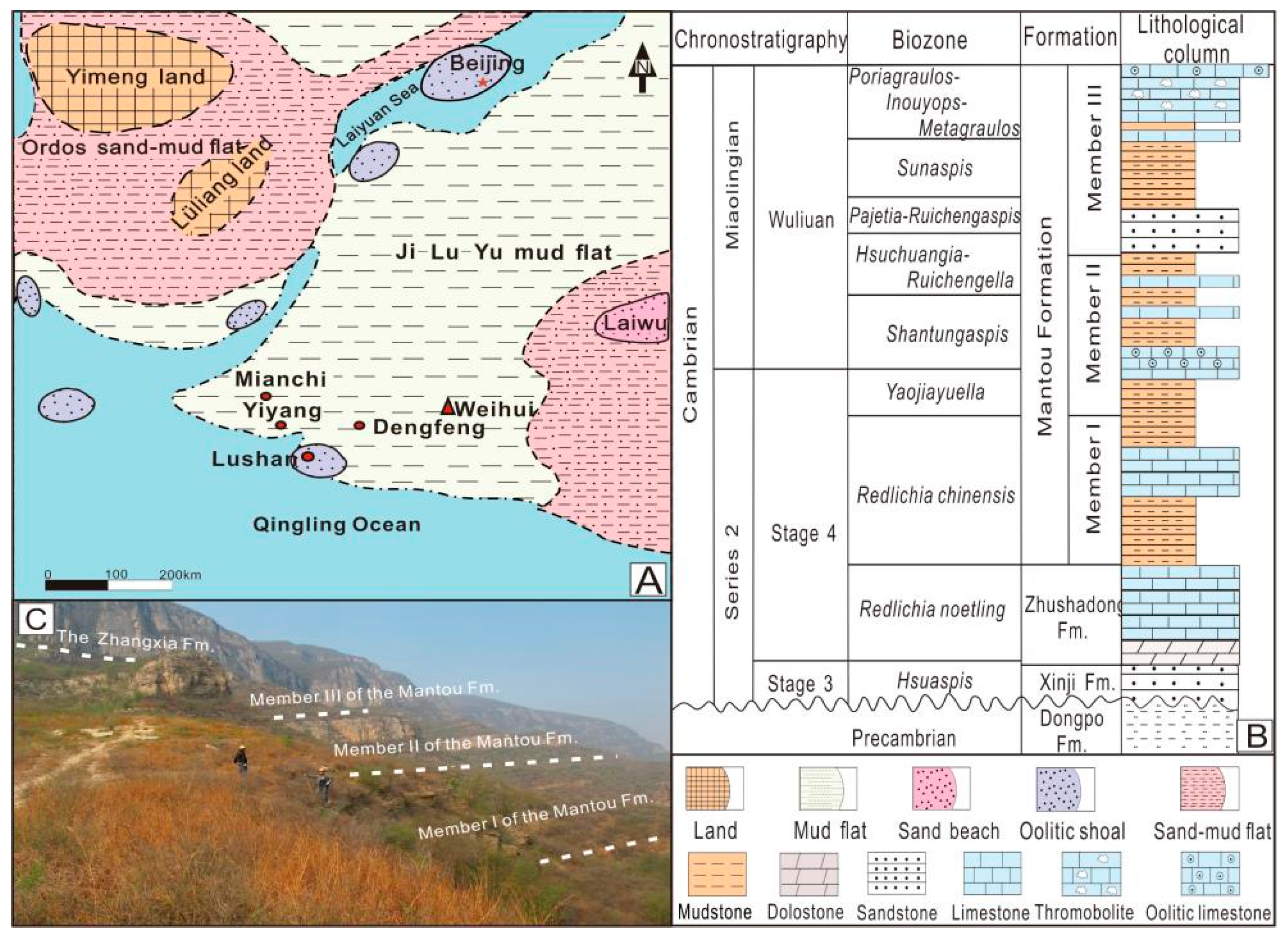

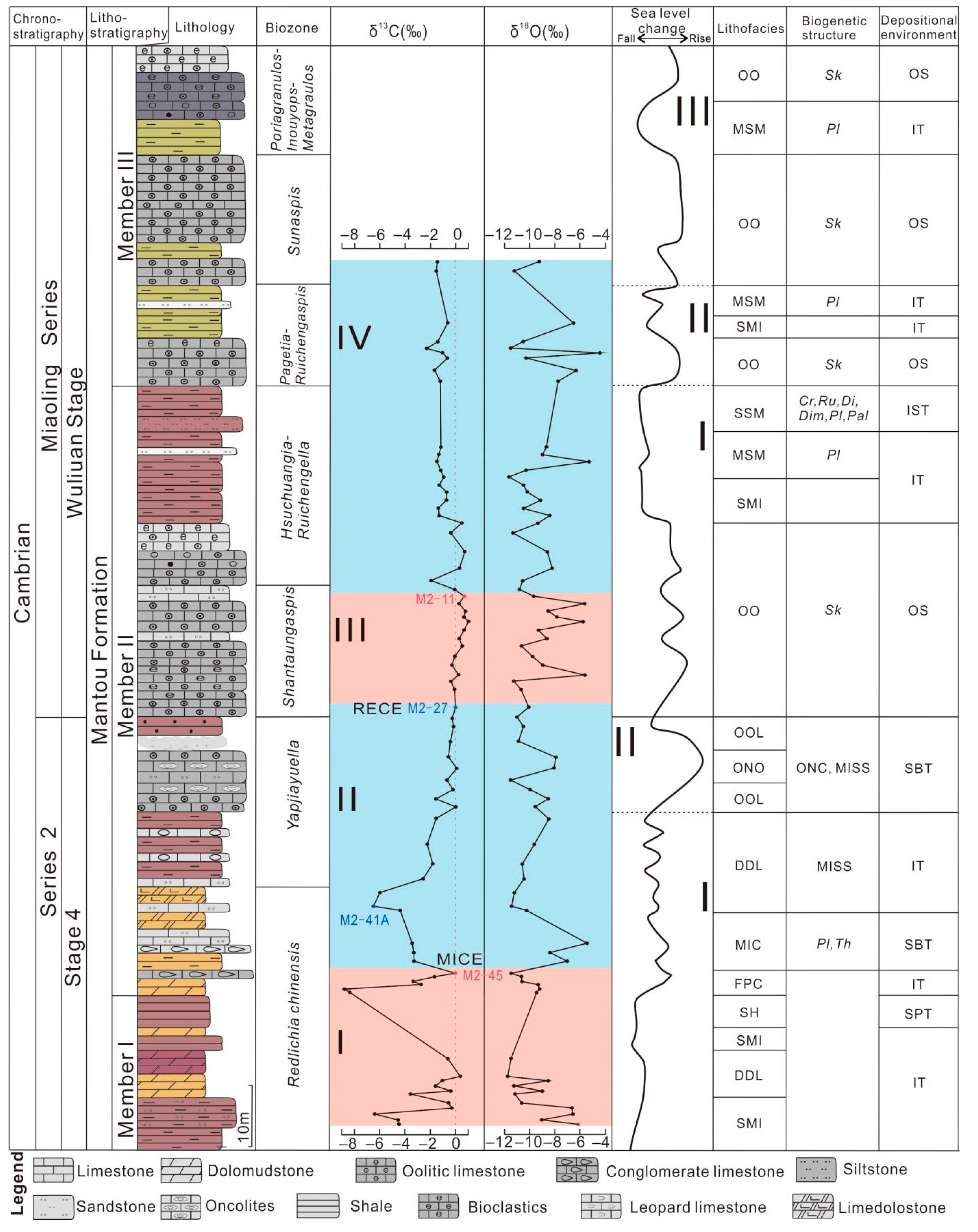
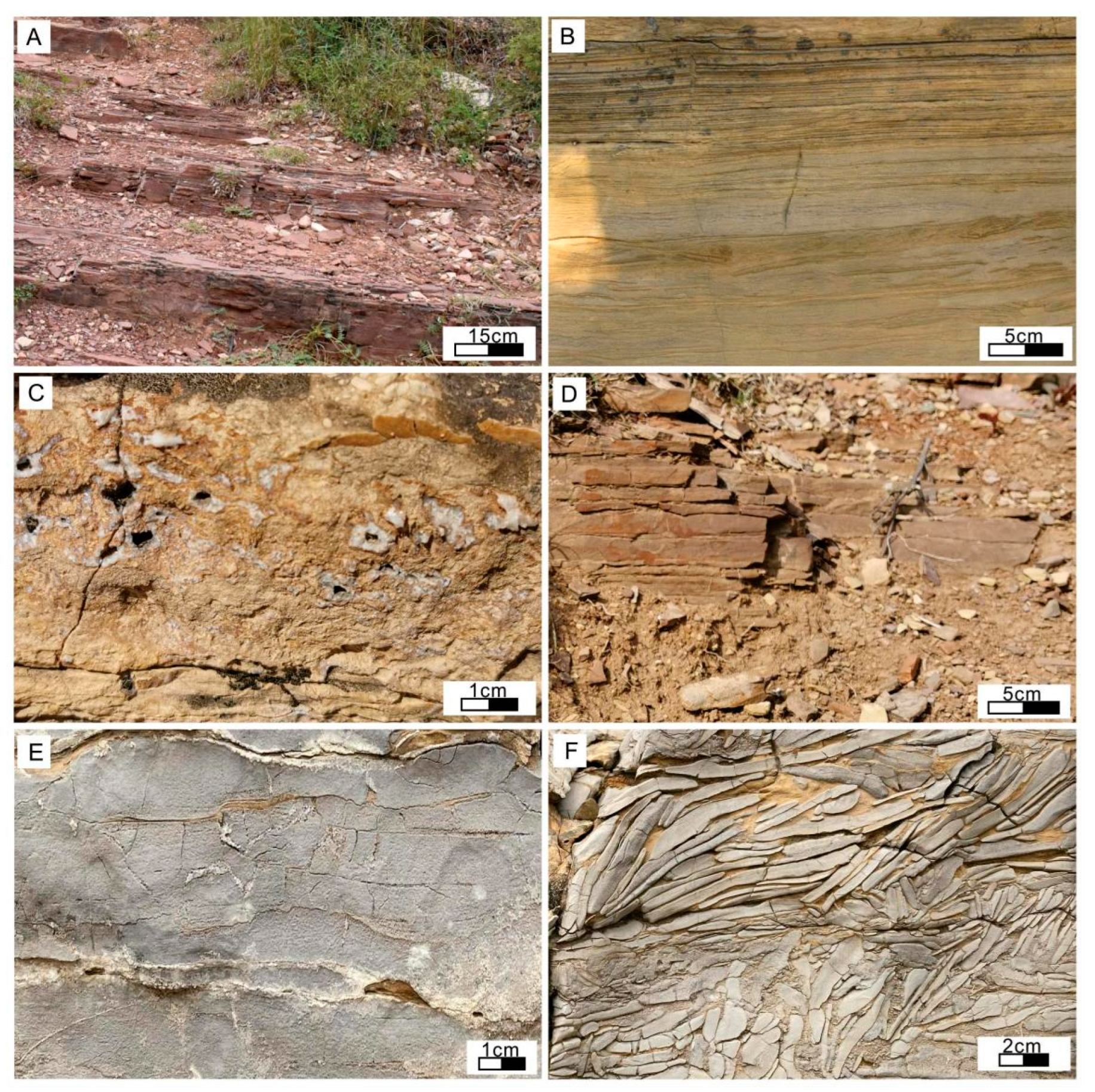

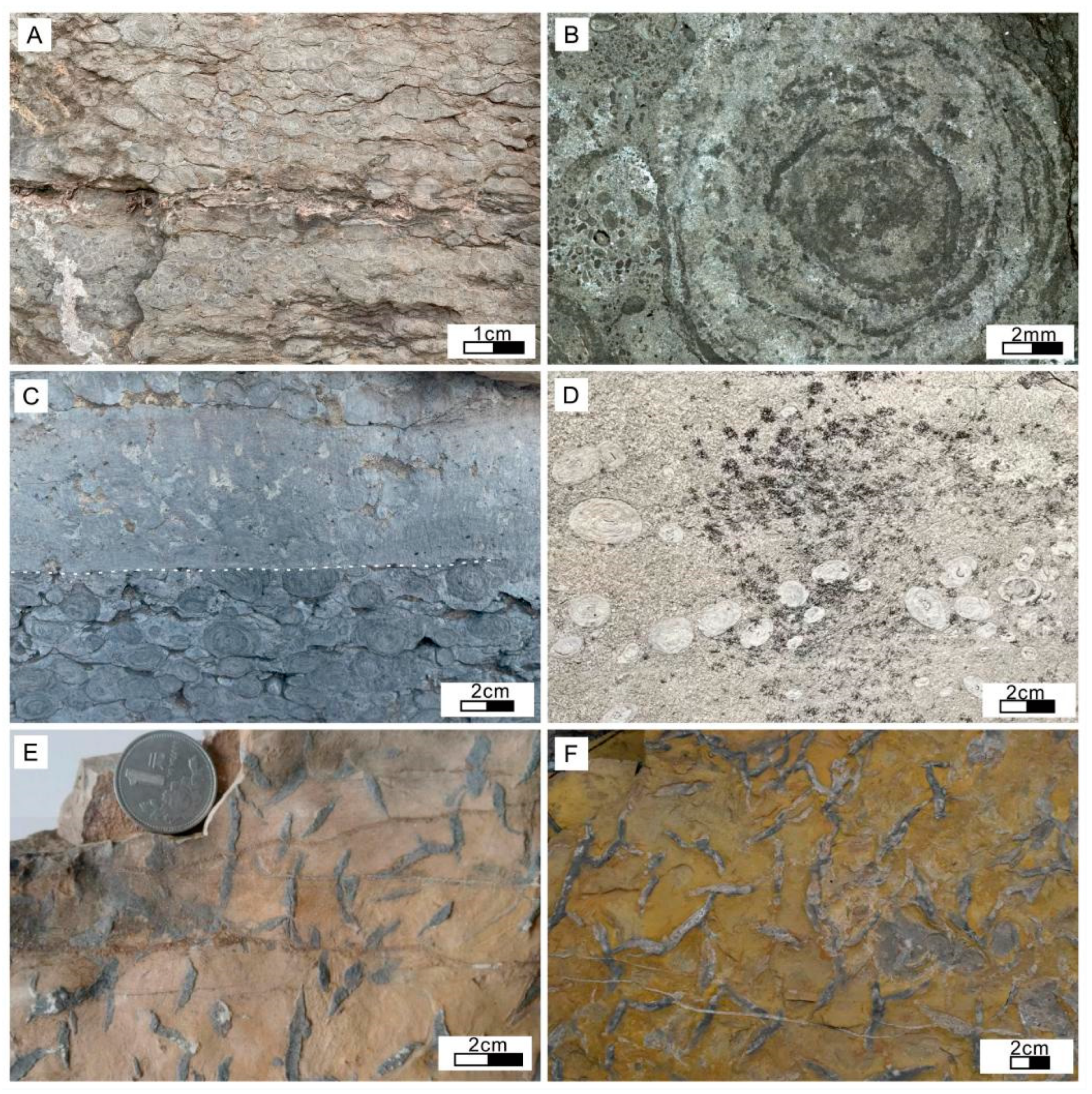

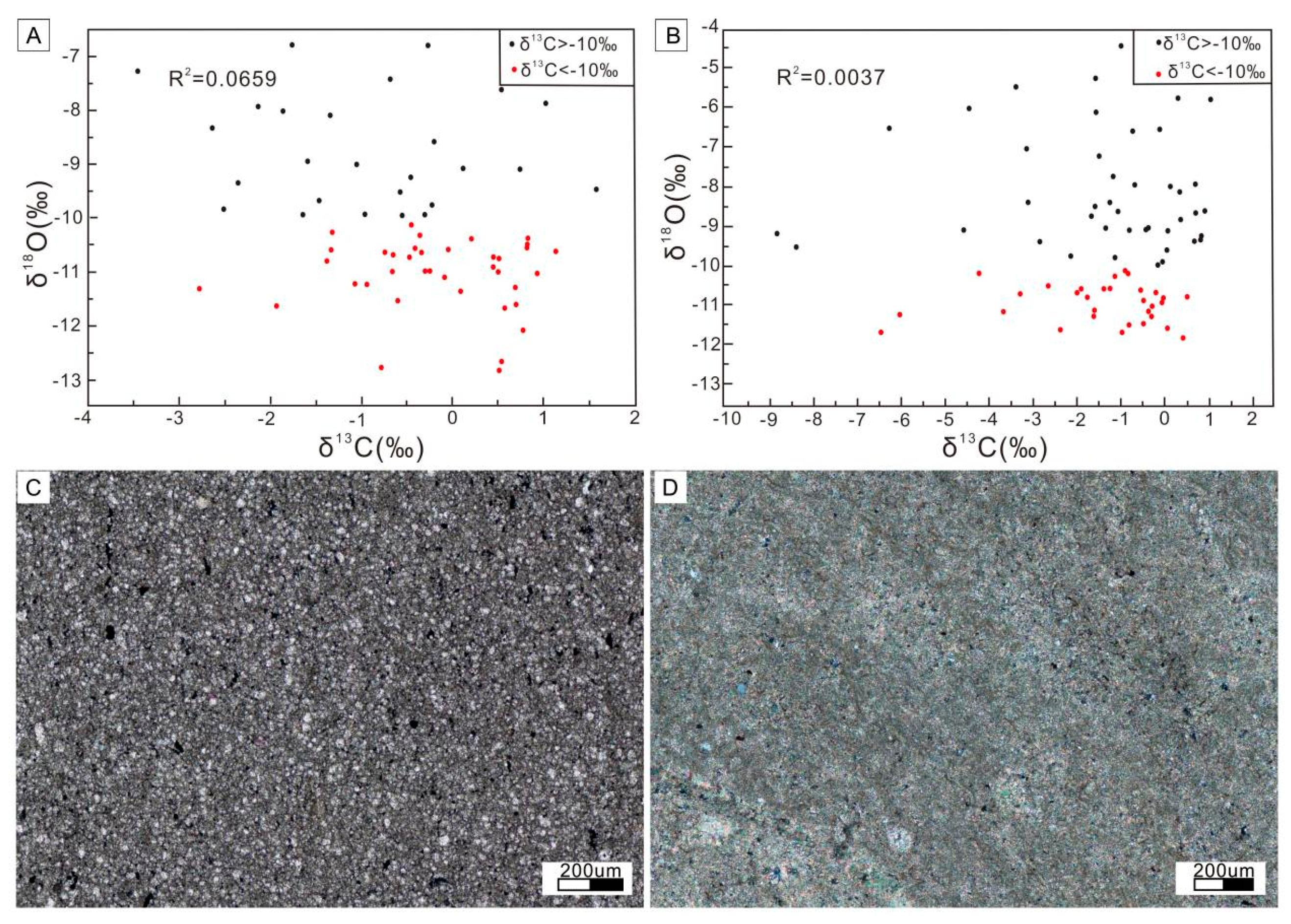
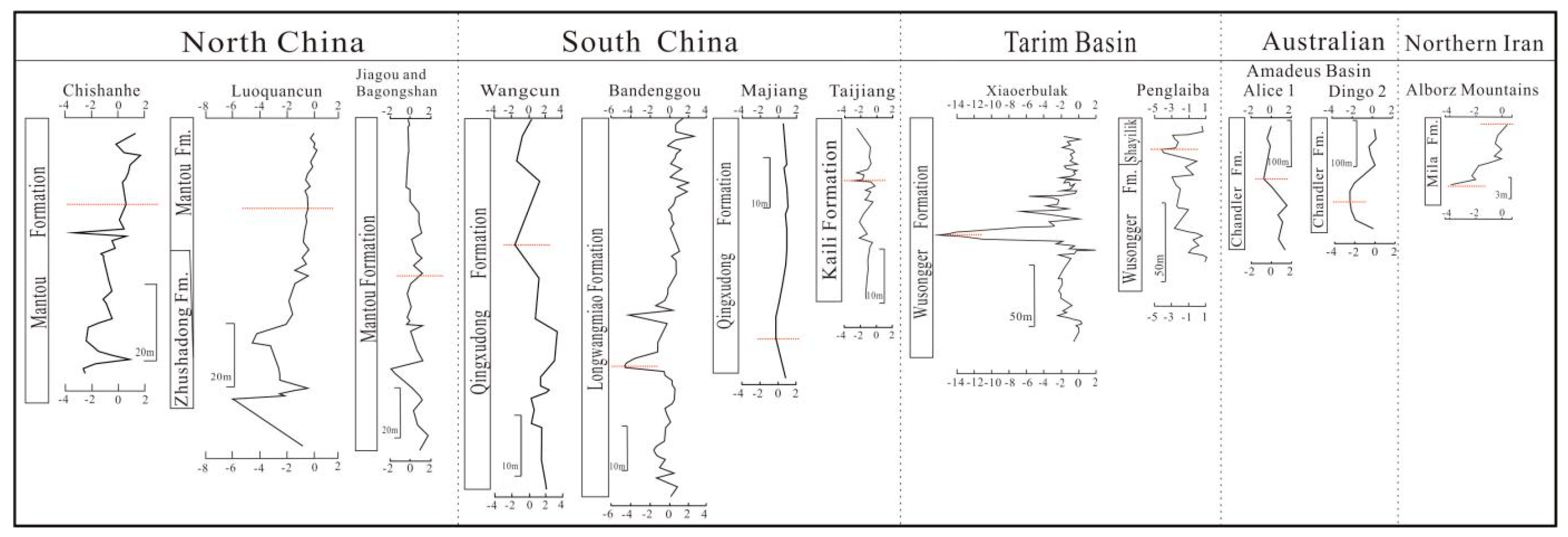

| Lithofacies Type | Biogenic Structures | Depositional Environment |
|---|---|---|
| Shale (SH) | supratidal zone (SPT) | |
| Alternation of dolostone and dolomitic limestone (DDL) | intertidal zone (IT) | |
| Siltstone with mudstone interbeds (SMI) | intertidal zone (IT) | |
| Micrite (MIC) | subtidal zone (SBT) | |
| Flat pebble conglomerate (FPC) | intertidal zone (IT) | |
| Oncolite-bearing limestone (OBL) | oncoids (ONC), microbially induced sedimentary structures (MISS) | subtidal zone (SBT) |
| Oncoidal oolitic limestone (OOL) | microbially induced sedimentary structures (MISS) | subtidal zone (SBT) |
| Oolite (OO) | trace fossils Skolithos (Sk) | oolite shoal (OS) |
| Fine sandstone interbedded with Siltstone and silty mudstone (SSM) | trace fossils Cruziana (Cr), Rusophycus (Ru), Diplichnites (Di), Dimorphichnus (Dim), Planolites (Pl), Palaeophycus (Pal) | intertidal–subtidal zone (IST) |
| Silty mudstone interbedded with Siltstone and micrite (MSM) | trace fossil Planolites (Pl) | intertidal zone (IT) |
| Sample ID | δ13C | δ18O | Rock | Number | δ13C | δ18O | Rock |
|---|---|---|---|---|---|---|---|
| M–65 | −0.65 | −10.66 | L | M–36 | 0.70 | −11.58 | L |
| M–64 | −0.58 | −9.52 | L | M–35 | 0.50 | −10.98 | L |
| M–63 | −0.34 | −10.62 | L | M–34 | 0.21 | −10.37 | L |
| M–62 | −0.27 | −6.78 | L | M–33 | 0.51 | −10.74 | L |
| M–61 | −0.41 | −10.54 | L | M–32 | −0.09 | −11.08 | L |
| M–60 | −1.07 | −11.20 | L | M–31 | 0.44 | −10.90 | L |
| M–59 | −0.94 | −11.21 | L | M–30 | −3.45 | −7.27 | M |
| M–58 | −1.86 | −8.02 | L | M–29 | 0.51 | −12.80 | L |
| M–57 | −0.30 | −9.94 | L | M–28 | −0.78 | −12.73 | L |
| M–56 | −0.25 | −10.97 | L | M–27 | −0.57 | −9.95 | L |
| M–55 | −1.33 | −10.57 | L | M–26 | −1.48 | −9.68 | L |
| M–54 | −0.36 | −10.30 | L | M–25 | −1.34 | −8.09 | L |
| M–53 | −0.47 | −10.70 | L | M–24 | −1.38 | −10.78 | L |
| M–52 | −0.04 | −10.57 | L | M–23 | −0.96 | −9.94 | L |
| M–51 | −0.22 | −9.76 | L | M–22 | −0.74 | −10.62 | L |
| M–49 | −0.30 | −10.97 | L | M–21 | −1.32 | −10.24 | L |
| M–48 | −0.66 | −10.97 | L | M–20 | −1.07 | −9.01 | D |
| M–47.5② | 0.09 | −11.34 | L | M–19 | −0.70 | −7.42 | D.L |
| M–47.5 | 0.57 | −11.65 | L | M–18 | −1.64 | −9.94 | L |
| M–47 | 0.54 | −12.64 | L | M–17.5 | −2.35 | −9.34 | L |
| M–46 | 0.78 | −12.06 | L | M–17 | −2.49 | −9.83 | L |
| M–45 | 0.69 | −11.27 | L | M–16 | −2.13 | −7.94 | L |
| M–44.5 | 0.54 | −7.62 | L | M–15 | −1.59 | −8.91 | L |
| M–44 | 0.82 | −10.52 | L | M–14 | −0.60 | −11.50 | L |
| M–43 | 0.82 | −10.47 | L | M–13 | 0.75 | −9.10 | L |
| M–42 | 0.93 | −11.01 | L | M–12 | −1.93 | −11.61 | L |
| M–41 | 1.59 | −7.27 | L | M–11 | −2.77 | −11.27 | L |
| M–40 | 1.13 | −10.60 | L | M–10 | −2.63 | −8.31 | L |
| M–39 | −0.45 | −10.11 | L | M–9 | −1.76 | −6.79 | D |
| M–38.5 | 0.45 | −10.70 | L | M–4 | −0.20 | −8.55 | D |
| M–38 | 1.57 | −9.46 | L | M–3 | −0.46 | −9.22 | D |
| M–37 | 0.83 | −10.36 | L | M–2 | 0.11 | −9.08 | D |
| M–1 | 1.03 | −7.87 | D |
| Sample ID | δ13C | δ18O | Rock | Number | δ13C | δ18O | Rock |
|---|---|---|---|---|---|---|---|
| M3-1 | −1.53 | −7.24 | L | M2-24 | −0.03 | −10.84 | L |
| M3-2 | −1.61 | −11.16 | L | M2-25 | 0.07 | −9.13 | L |
| M3-3 | −0.75 | −6.57 | L | M2-26 | −0.33 | −11.04 | L |
| M3-4 | −1.33 | −10.56 | L | M2-27 | −0.20 | −10.69 | L |
| M3-5 | −2.38 | −11.62 | L | M2-28 | −0.48 | −10.90 | L |
| M3-6 | −1.03 | −4.46 | L | M2-29 | −0.69 | −7.97 | L |
| M3-7 | −0.85 | −10.20 | L | M2-30 | 0.13 | −8.01 | L |
| M3-8 | −1.60 | −6.13 | L | M2-31 | −0.82 | −11.51 | L |
| M3-9 | −1.18 | −7.77 | L | M2-32 | −0.15 | −9.99 | L |
| M3-10 | −1.13 | −9.81 | L | M2-33 | 0.05 | −9.62 | L |
| M3-11 | −1.35 | −9.06 | L | M2-34 | −1.70 | −8.76 | L |
| M3-12 | −1.57 | −5.27 | L | M2-35 | −1.63 | −8.51 | L |
| M3-13 | −1.13 | −10.30 | L | M2-37 | −2.14 | −9.77 | L |
| M3-14 | −0.97 | −11.70 | L | M2-38 | −1.91 | −10.62 | L |
| M3-15 | −1.24 | −10.57 | L | M2-39 | −2.64 | −10.51 | L |
| M3-16 | −0.89 | −10.15 | L | M2-40 | −6.05 | −11.24 | L |
| M3-17 | −0.81 | −9.13 | L | M2-41A | −6.46 | −11.67 | L |
| M3-18 | −1.39 | −10.58 | L | M2-41B | −4.24 | −10.21 | L |
| M3-19 | −1.26 | −8.41 | L | M2-42 | −3.39 | −5.49 | L |
| M3-20 | 0.68 | −9.38 | L | M2-43 | −3.14 | −8.41 | L |
| M2-5 | −0.32 | −11.29 | L | M2-44 | −3.18 | −7.06 | L |
| M2-7 | 0.71 | −8.68 | L | M2-45 | 0.05 | −11.59 | L |
| M2-8 | 0.33 | −8.15 | L | M2-46 | −1.75 | −10.81 | L |
| M2-9 | −1.99 | −10.68 | L | M2-47 | −3.30 | −10.73 | L |
| M2-10 | −0.06 | −10.93 | L | M2-48 | −2.84 | −9.40 | L |
| M2-11 | 0.82 | −9.28 | L | M2-49 | −8.82 | −9.20 | L |
| M2-12 | 0.29 | −5.78 | L | M2-50 | −8.42 | −9.55 | L |
| M2-13 | 0.91 | −8.63 | L | M1-2 | −0.49 | −11.47 | D |
| M2-14 | 0.70 | −7.96 | L | M1-3 | 0.40 | −11.83 | D |
| M2-15 | 1.04 | −5.81 | L | M1-4 | −1.07 | −8.64 | L |
| M2-16 | 0.81 | −9.36 | L | M1-5 | −1.60 | −11.35 | L |
| M2-17 | 0.35 | −8.84 | L | M1-6 | −0.42 | −9.08 | D |
| M2-18 | 0.50 | −10.81 | L | M1-7 | −3.67 | −11.15 | D |
| M2-19 | −0.06 | −9.92 | L | M1-8 | −0.55 | −10.64 | D |
| M2-20 | −0.38 | −9.06 | L | M1-10 | −0.16 | −6.58 | L.D |
| M2-21 | 0.23 | −5.78 | L | M1-11 | −6.30 | −6.54 | D |
| M2-23 | −0.37 | −11.15 | L | M1-12 | −4.58 | −9.10 | D |
| M1-13 | −4.45 | −6.04 | D |
Publisher’s Note: MDPI stays neutral with regard to jurisdictional claims in published maps and institutional affiliations. |
© 2022 by the authors. Licensee MDPI, Basel, Switzerland. This article is an open access article distributed under the terms and conditions of the Creative Commons Attribution (CC BY) license (https://creativecommons.org/licenses/by/4.0/).
Share and Cite
He, W.-Y.; Qi, Y.-A.; Dai, M.-Y.; Liu, B.-C.; Li, J.-B.; Xu, G.-X.; Wang, M.; Li, D. Facies Changes, Evolution of Biogenic Structures, and Carbon Isotope Stratigraphy of the Cambrian Series 2 to Miaolingian Transition on the Southern North China Craton. Minerals 2022, 12, 1526. https://doi.org/10.3390/min12121526
He W-Y, Qi Y-A, Dai M-Y, Liu B-C, Li J-B, Xu G-X, Wang M, Li D. Facies Changes, Evolution of Biogenic Structures, and Carbon Isotope Stratigraphy of the Cambrian Series 2 to Miaolingian Transition on the Southern North China Craton. Minerals. 2022; 12(12):1526. https://doi.org/10.3390/min12121526
Chicago/Turabian StyleHe, Wen-Yi, Yong-An Qi, Ming-Yue Dai, Bing-Chen Liu, Jing-Bo Li, Gan-Xiao Xu, Min Wang, and Da Li. 2022. "Facies Changes, Evolution of Biogenic Structures, and Carbon Isotope Stratigraphy of the Cambrian Series 2 to Miaolingian Transition on the Southern North China Craton" Minerals 12, no. 12: 1526. https://doi.org/10.3390/min12121526
APA StyleHe, W.-Y., Qi, Y.-A., Dai, M.-Y., Liu, B.-C., Li, J.-B., Xu, G.-X., Wang, M., & Li, D. (2022). Facies Changes, Evolution of Biogenic Structures, and Carbon Isotope Stratigraphy of the Cambrian Series 2 to Miaolingian Transition on the Southern North China Craton. Minerals, 12(12), 1526. https://doi.org/10.3390/min12121526




